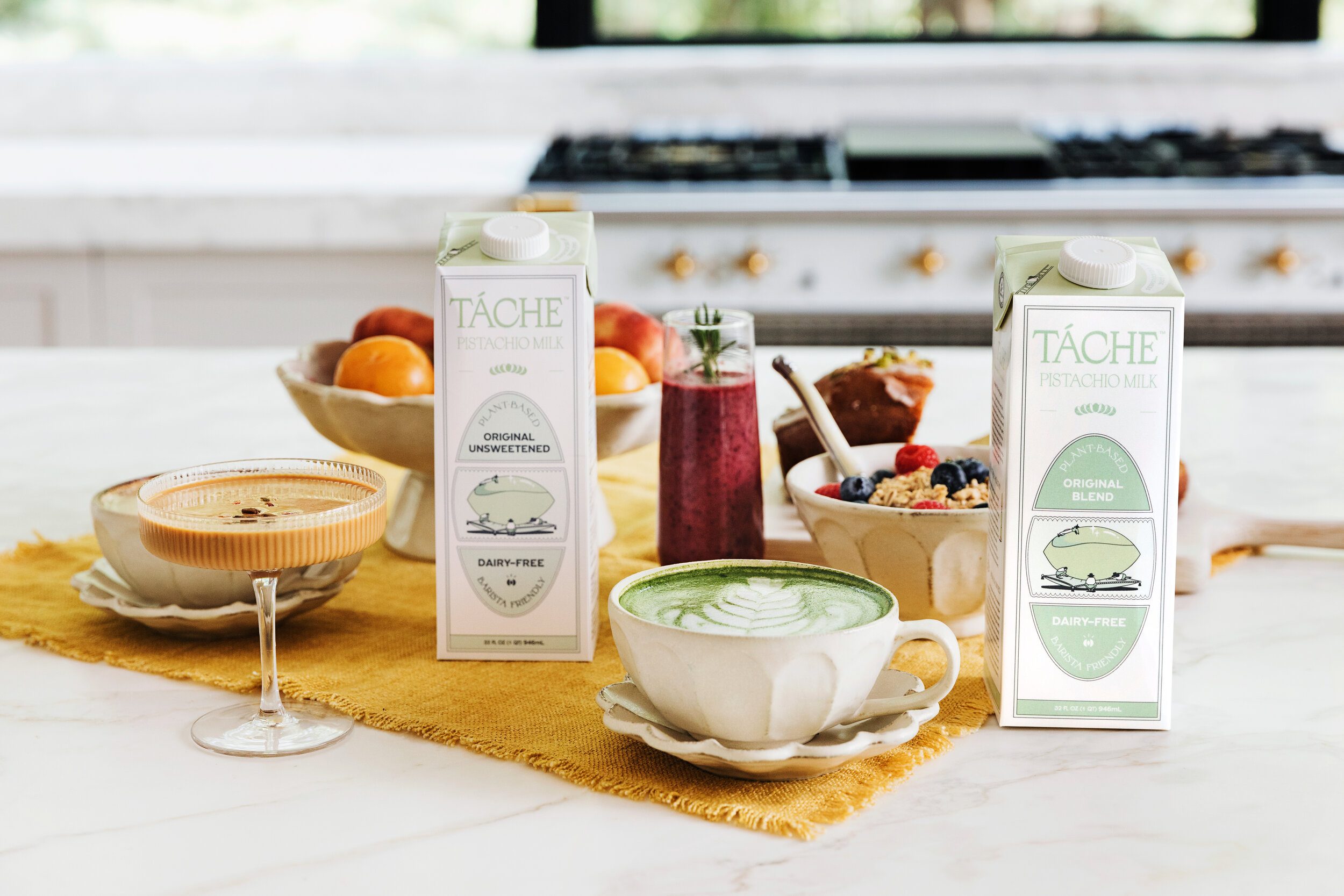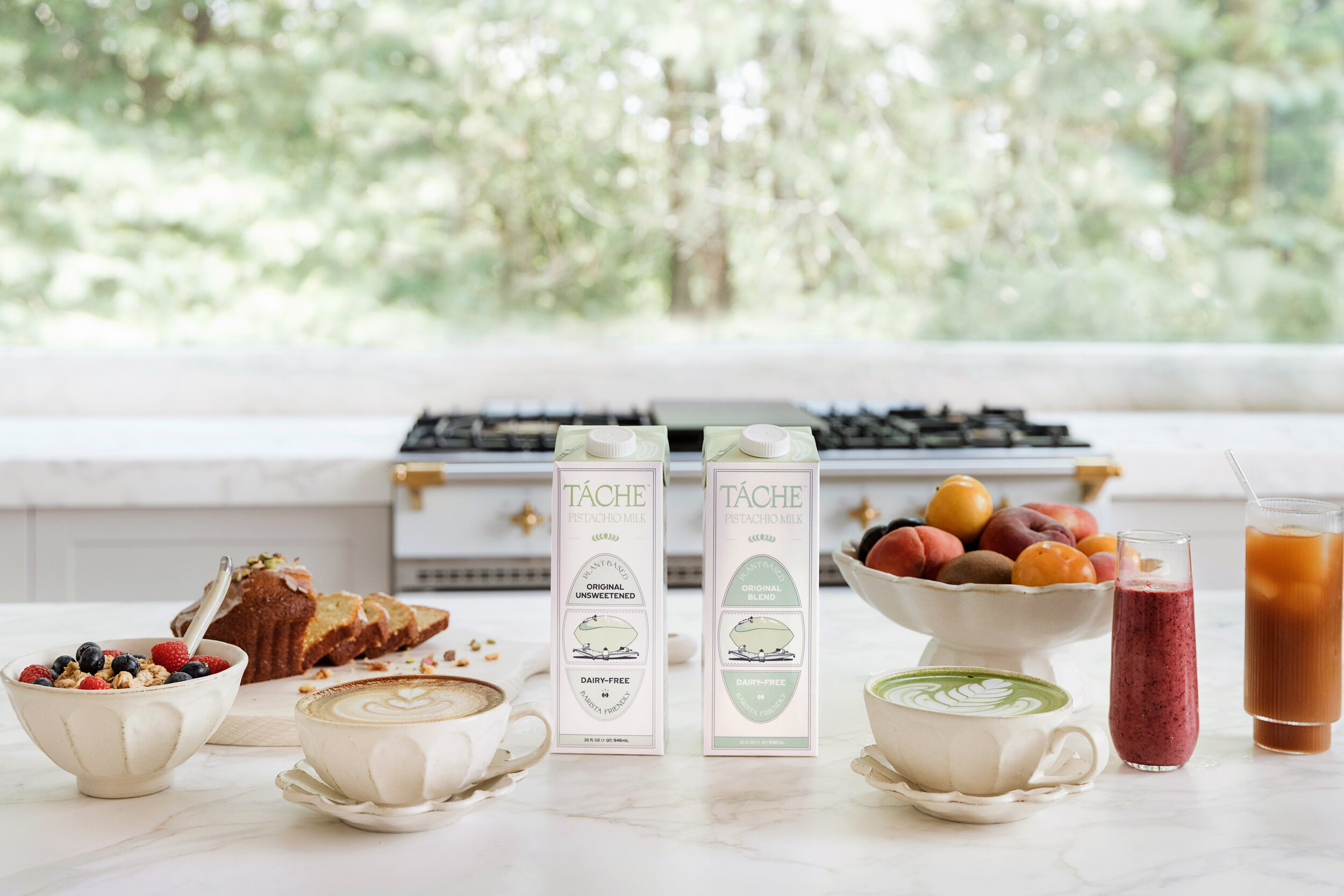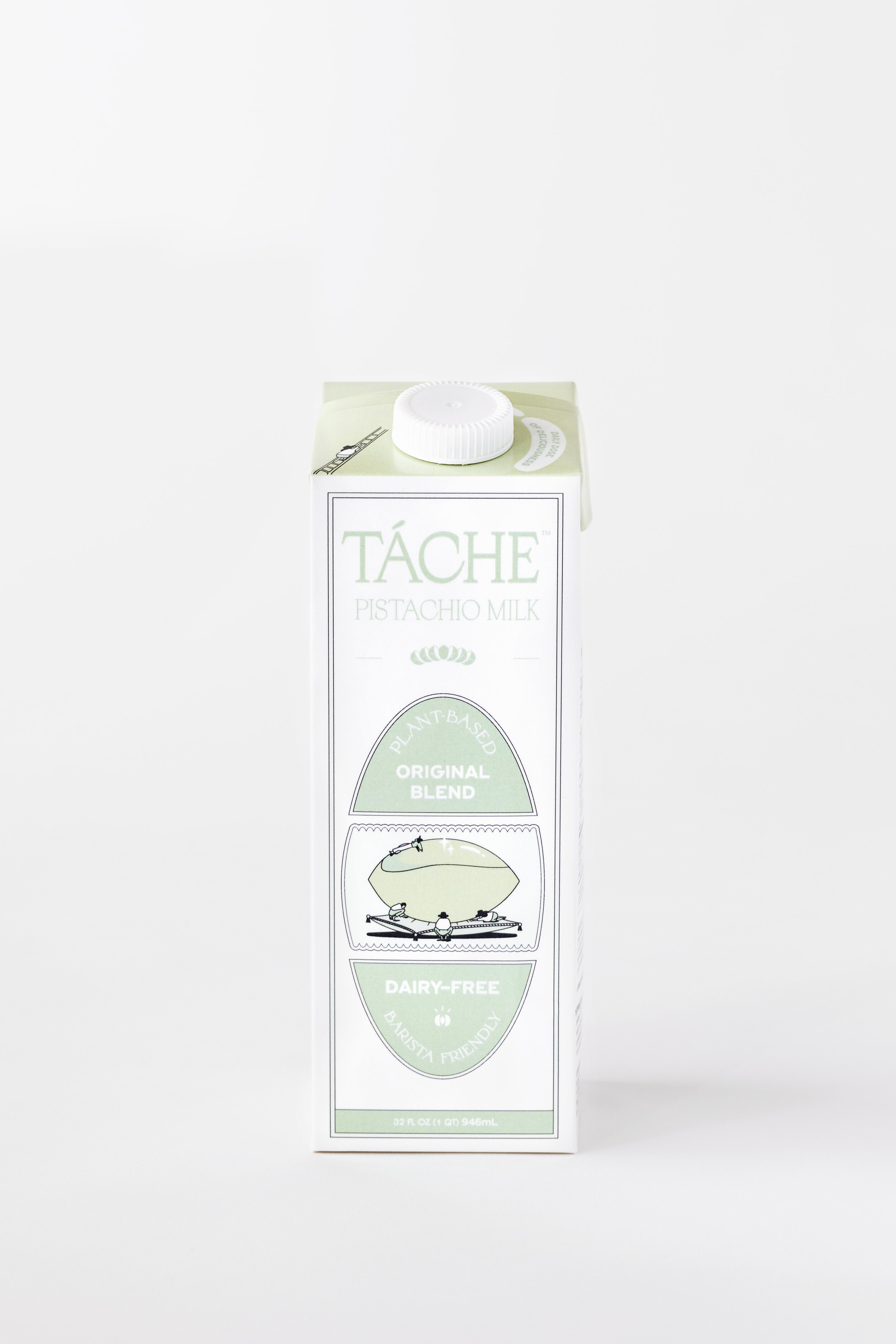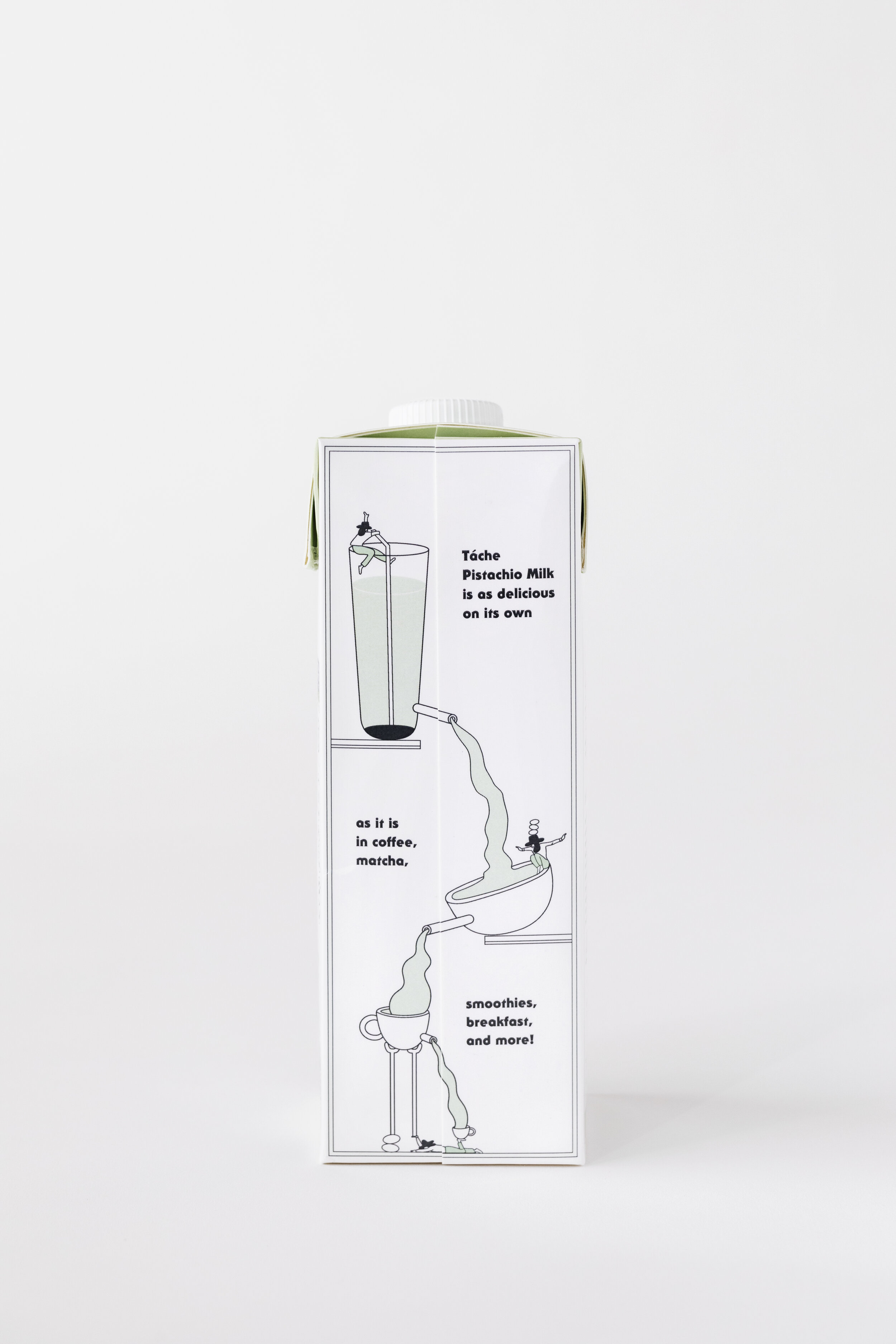TACHE, ROXANA SAIDI: The Nut Milk Alternative
Healthy dairy alternatives are on the rise and it is anticipated that the market will reach over $35 USD billion by 2026. Almond and oat milk have seen increased popularity and interest, but there are other nut milks to discover as well. After traveling to Europe and being unable to get the right milk for her latte, Roxana Saidi launched Táche and is now paving the way with the latest milk alternative using a fan favorite nut: the pistachio.
We talked to co-founder and CEO Roxana Saidi about her passion for pistachios that led to her creating Táche, closing her fundraising round, and managing a robust supply chain.
Roxana was born in San Francisco to a serial entrepreneurial and engineer father, which gave her a leg up in the entrepreneurial world. In her household, terms like VC, startup, capital, and fundraising were all in her lexicon from a very young age. She learned early on what it meant to fundraise, what hard work and work ethic was, and what being an entrepreneur looked like.
After graduating from CU Boulder with a marketing degree, she had pressure from her dad to pursue an MBA, however, she was more interested in choosing the path less taken and launched her own social media agency, Rx Social.
It wasn’t until a dairy detox and trip under belt to Paris with her family that Roxana was craving an almond milk latte, which unfortunately, wasn't available in Europe at the time. She was also craving a more flavorful taste and was feeling nostalgic for pistachios since her father is Iranian and it is a common staple back home.
The Aha Moment
“We always have pistachios on hand in my household, they are just a staple in Middle Eastern households. So I thought I could try the idea of making pistachio milk myself because you’re almost guaranteed to have more flavorful experience than with almond milk,” said Roxana.
Fast forward to November 2020 and with five years in the making, Roxana launched Táche, a new nut milk alternative. Like many other businesses impacted by the pandemic, Táche is no different. It’s main channels of distribution include D2C and in-person stores like coffee shops. However, as you would have guessed it, Táche is leaning heavily towards the D2C model at the moment.
Consumer Testing and Development
DIY! Roxana started tinkering with different pistachio milk recipes from DIY blogs in her studio kitchen, letting friends try her concoctions first. “The more people who tasted it, the more they loved it and said they would drink it by itself. That made me really think there’s a lot of potential here, so why doesn’t this product exist in the market?” Roxana said. After a profuse amount of research, Roxana found the answer to her questions regarding the difficulty to bring this product to life: the supply chain.
But why the hype with pistachios you might be wondering? Pistachios are a premium nut, incredibly melatonin rich and full of antioxidants, some that even boost your eye health. They are a complete protein with all 9 amino acids, and are one of the healthiest foods on the market. “For generations, pistachios have always been a premium product at a higher price point than a lot of other nuts. So, if you can nail the supply chain of really high quality pistachios at an approachable price, you got it, but that is incredibly challenging to do,” Roxana said.
Branding and naming were also two important pillars for a successful D2C company launch. Why the name? “Táche is the middle syllable of pistachio, and was the third name for the company. One of my pieces of advice I give every entrepreneur is to go to the USPTO (United States Patent and Trademark Office) first and research whether or not your name is available to be trademarked, Instagram should be second,” advised Roxana. As for the branding, Futura, an agency out of Mexico City is responsible for the memorable illustrations and clever artwork.
As the product progressed, the core customer base needed to be determined. Roxana believes that consumer development comes in three layers. Friends and family, skeptics of alternative milk and the experts - the baristas and coffee enthusiasts. It is important to target the skeptics or non-traditional customers as they provide brands with raw data that is vital for positioning.
CEO Roxana and her co-founder, father.
“My sample size got really big because I came up with the idea in 2015, so fast forward to 2018-2019, I had hundreds of people sampling Táche. These included everyone from friends of friends, random people from hosted events, to me sneaking Táche into the NYC Coffee Festival two times...and from all of the feedback I’ve collected, it does not make sense to me how well it performs. I still struggle to find people who say I’m repulsed,” said Roxana. We agree too! Radiche was able to sample the goods, and we approved. Love, love, love!
When it comes to ta ta ta…. The supply chain, Roxana found a great manufacturer in Canada, but required a high MOQ. Why Canada eh? “North America is really slow to pick up on Tetra Pak and aseptic manufacturing, there are very few manufacturers who can command very high minimum order quantities (MOQ), which ultimately prevents small startups from breaking into the market. Typically, these manufacturers command 100K units or more for the very first run so a company has to scale before launch,” Roxana said.
Alas, Roxana was able to raise funding (right as the pandemic hit too) and garnered $1.1M from mentors and investors such as Gary Hirshberg, a legendary figure in the natural yogurt industry, and Kevin Huvane of CAA.
The Pandemic and Business
While coffee shops closed their doors around NYC, D2C sales shot through the roof. “These products are good for 12 months unopened, so you can stock up on shelf stable almond milk or oat milk, and what we found was that these milk alternatives were one of the top three items alongside sanitizer and other necessities during the pandemic. This was one of our learnings -- that we had a product that was pandemic proof, and that shoppers were going out and buying it in huge numbers,” said Roxana.
With so many consumers looking for alternative and healthier ways of consumption, this is a valuable time for a CPG brand to infiltrate into the market from a DTC level. Táche has also found that their customer base consists of many people leading an active and healthy lifestyle, people who care a lot about what they are consuming -- a trend that will continue during the pandemic and beyond.
“In the last few weeks, unsweetened pistachio milk has sold almost as well as original pistachio milk, which really shows you people’s lifestyles and how they’re leading them, as well as what they care about consuming. The surprising part has actually been finding out that quite a number of our DTC customers are a bit older which is great and I just think that’s a natural result of shopping from home and shopping less in person. Our customer base is really all over the map from the mom to the young teenager, but the bottom line is caring about what is on the nutrition label, what we are putting in our bodies, and overall healthy eating,” Roxana said.
The Advice
For those early-stage founders trying to tackle a product company, here is Roxana’s advice:
As soon as you figure out a brand name, check with the trademark office first. Naming is important!
Be assertive and trust your gut.
When it comes to fundraising, don’t be afraid of raising a number that feels aggressive or intimidating. Talk yourself out of “making more with less.” My advice is to not be afraid of a big number. Ask for it.
Be prepared to worry about things you never thought you would worry about, AKA the supply chain and container packaging.
Come to work with a problem-solving mindset every day and expect things to go wrong.
Interested in trying Táche, while also giving back to the community? Purchase from the site and a portion will go to the Lower Eastside Girls Club, an organization that serves to empower young teenage girls in entrepreneurship and education.
Photo courtesy of Tache.
Written by Christina Chao.








